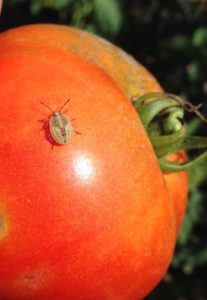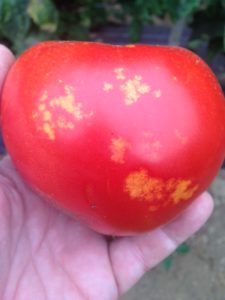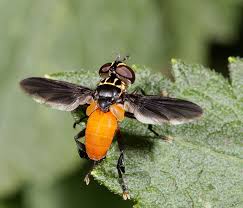Sweet Corn
European corn borer (ECB) moth catches continue to be extremely low around the state. We are in between adult generations at this time. ECB population maps will resume if second flight catches rise to high enough numbers.
The highest nightly trap catches of ECB for the week ending 07/13/22 are as follows:
| Hillsborough 1 | Port Murray 1 |
| Milford 1 | Sergeantsville 1 |
| Milltown 1 | South Branch 1 |
| Oldwick 1 |
Data from some southern NJ locations is unavailable, and no blacklight map will appear in this edition. Corn earworm (CEW) moths captures from accessible blacklight traps are very low, but pheromone trap captures are higher in some southern parts of the state. The number of pheromone traps deployed is much lower, resulting in much broader color bands on the map. It is also important to understand that pheromone traps are more sensitive than blacklight traps, and thresholds are adjusted to account for the higher catches typical of this trap type. Silking corn is at risk of CEW infestation at this time. On the pheromone map (below right), red represents a 3 day spray schedule, green represents a 4-5 day schedule, and blue represents a 5-6 day schedule. Be sure to access information from this publication in the upcoming weeks to determine how frequently you should treat silking sweet corn to protect it from CEW infestation.
The highest nightly blacklight trap catches of CEW for the week ending 07/13/22 are as follows:
| Bellemeade 1 | Pennington 1 |
| Georgetown 1 | |
| Matawan 1 | |
| Morristown 1 |
The highest nightly pheromone trap catches of CEW for the week ending 07/13/22 are as follows:
| Beckett 26 | Green Creek 3 | Chester 1 |
| Tabernacle 15 | Allamuchy 2 | Farmingdale 1 |
| Woodstown 8 | Dayton 2 | Matawan 1 |
| Eldora 6 | Pedricktown 2 | South Branch 1 |
Silking Spray Schedules*:
South – 4 days
Central – 4-5 days
North – 5-6 days
*These recommendations are based on regional catches. Adhere to tighter spray schedules if indicated by local trap catches. Synthetic pyrethroids alone should NOT be used for corn earworm (CEW) protection on silking corn, or for fall armyworm (FAW) management at any stage. Control with these materials is very inconsistent. Utilize materials in IRAC groups 5 and 28, or combination products that include IRAC group 28 for best control. See the Sweet Corn section of the 2022-23 Commercial Vegetable Production Guide for selections.
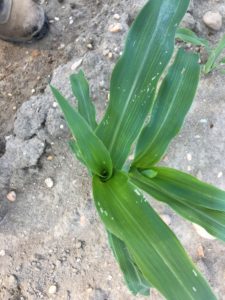
 Fall armyworm (FAW) larval infestations that were found from Cape May County northward through Monmouth County in recent weeks have not increased, nor spread. However, late July is generally the time of the summer when FAW can show up, resulting in significant injury to whorl and even seedling stage corn. Injury from newly hatched larvae shows up as “window panes” or areas where leaf tissue has been eaten down the the lower epidermis (see photo at far left). This injury leads down into the whorl. As larvae gain size, they begin to consume leaf tissue in its’ entirety, creating ragged holes and lots of droppings (see photo at near left). FAW can be tough to manage because it is resistant to synthetic pyrethroid insecticides (IRAC 3A) and because larvae are often covered by their own droppings, making contact with the insecticide more difficult. Treat when 12% or more plants exhibit FAW injury alone, or in combination with ECB injury. As a rule, insecticides that are most effective on CEW will also adequately control FAW.
Fall armyworm (FAW) larval infestations that were found from Cape May County northward through Monmouth County in recent weeks have not increased, nor spread. However, late July is generally the time of the summer when FAW can show up, resulting in significant injury to whorl and even seedling stage corn. Injury from newly hatched larvae shows up as “window panes” or areas where leaf tissue has been eaten down the the lower epidermis (see photo at far left). This injury leads down into the whorl. As larvae gain size, they begin to consume leaf tissue in its’ entirety, creating ragged holes and lots of droppings (see photo at near left). FAW can be tough to manage because it is resistant to synthetic pyrethroid insecticides (IRAC 3A) and because larvae are often covered by their own droppings, making contact with the insecticide more difficult. Treat when 12% or more plants exhibit FAW injury alone, or in combination with ECB injury. As a rule, insecticides that are most effective on CEW will also adequately control FAW.
Tomatoes
As we move into July, brown stink bug injury will likely increase. These true bugs (see photo of Euschistus sp. nymph below at left), move into irrigated tomato fields as forage in the surrounding environment dries out. Feeding results in “cloudy spot” (see photo at right below). Increases in stink bug injury are often found by crews picking the fruit. Growers should consider 1-2 insecticide applications to limit fruit injury if this damage is increasing in harvested fruit. If actively scouting fields, insecticides should be considered if stink bug adults, nymphs or new fruit injury is found in 2 or more sample sites in a 10 site sample. Insecticides that are effective on stink bugs include pyrethroids and neonicotinoids, so care should be taken to avoid contact with foraging bees.
Peppers
Pepper weevil – No weevils have been captured in pheromone traps. We are not aware of any fields having infestations. A new fact sheet is now available for anyone interested in monitoring for pepper weevils on their own: FS1330: Monitoring and Management of Pepper Weevil in New Jersey (Rutgers NJAES).
Pumpkins and Winter Squash
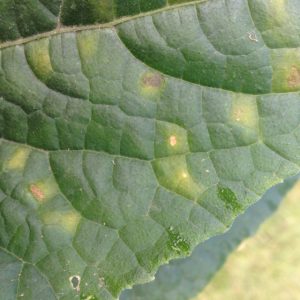 Cucurbit downy mildew (CDM) has been detected on cucumbers in Salem, Middlesex, Mercer and Hunterdon
Cucurbit downy mildew (CDM) has been detected on cucumbers in Salem, Middlesex, Mercer and Hunterdon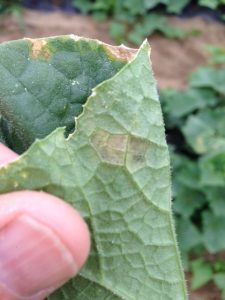 counties and should be considered active on cucumbers in all parts of the state. As yet, other cucurbits, including pumpkins, butternut squash, acorn squash and watermelons are unaffected. Wet weather favors CDM, and disease incidence on affected crops may worsen significantly under these conditions. Yellow lesions form on the upper surface of infected tissue (see photo at left). Often these lesions are bordered by veins until the infection spreads across the entire leaf. Under humid conditions, dark sporulation (photo at right) can be found on the lower leaf surface. For regional information on this important disease, see the Cucurbit Downy Mildew Forecast webpage: http://cdm.ipmpipe.org/. This forecast has NJ at moderate-to-high risk of further infection through Tuesday 7/12. It is advisable that all growers treat preventively for CDM on cucumbers and muskmelons. As yet, there have been no reports in the mid-Atlantic region of CDM affecting any other cucurbit crops. This is important, as pumpkins and winter squash are now active crops in the region.
counties and should be considered active on cucumbers in all parts of the state. As yet, other cucurbits, including pumpkins, butternut squash, acorn squash and watermelons are unaffected. Wet weather favors CDM, and disease incidence on affected crops may worsen significantly under these conditions. Yellow lesions form on the upper surface of infected tissue (see photo at left). Often these lesions are bordered by veins until the infection spreads across the entire leaf. Under humid conditions, dark sporulation (photo at right) can be found on the lower leaf surface. For regional information on this important disease, see the Cucurbit Downy Mildew Forecast webpage: http://cdm.ipmpipe.org/. This forecast has NJ at moderate-to-high risk of further infection through Tuesday 7/12. It is advisable that all growers treat preventively for CDM on cucumbers and muskmelons. As yet, there have been no reports in the mid-Atlantic region of CDM affecting any other cucurbit crops. This is important, as pumpkins and winter squash are now active crops in the region.
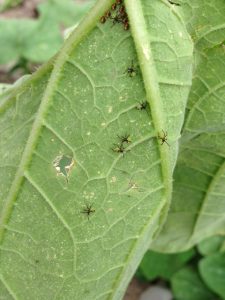
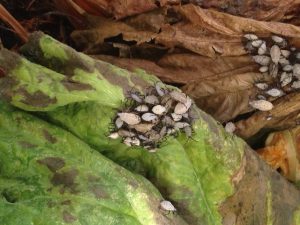 Squash bugs are appearing in pumpkin fields at this time. Plants that are beyond the 4 true leaf stage are at minimal risk from feeding by squash bugs, and treatment is rarely necessary. Nymphs hatch from copper colored egg masses, and change form dramatically as they go through several molts. Starting as clusters of small greenish nymphs (left), they ultimately become elongated and light gray in color (right). A black and orange fly is common in pumpkin plantings when squash bug are present (see photo from Texas A&M below at left). This fly (Trichopoda pennipes) is a parasite of the squash but, and not a pest of the crop.
Squash bugs are appearing in pumpkin fields at this time. Plants that are beyond the 4 true leaf stage are at minimal risk from feeding by squash bugs, and treatment is rarely necessary. Nymphs hatch from copper colored egg masses, and change form dramatically as they go through several molts. Starting as clusters of small greenish nymphs (left), they ultimately become elongated and light gray in color (right). A black and orange fly is common in pumpkin plantings when squash bug are present (see photo from Texas A&M below at left). This fly (Trichopoda pennipes) is a parasite of the squash but, and not a pest of the crop.
Growers with giant pumpkins, or small plantings should be aware 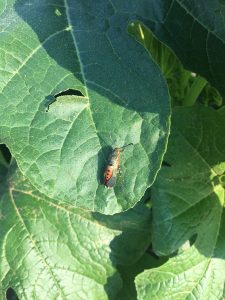 that this is the time when squash vine borer moths are active. This moth resembles a wasp (photo at left), and is typically active early in the morning and again at dusk. Females lay eggs at the base of plants, just above the soil line. The emerging caterpillars bore into the main stem and can cause plants to wilt and die. Larger stemmed cucurbits, such as giant pumpkins and summer squash are favored hosts, and very small garden plots can be heavily impacted. Insecticides labeled for squash vine borer are primarily pyrethroids (IRAC 3A), and recommendations may be found in the Pumpkin and Winter Squash section of the 2022-23 Vegetable Guide.
that this is the time when squash vine borer moths are active. This moth resembles a wasp (photo at left), and is typically active early in the morning and again at dusk. Females lay eggs at the base of plants, just above the soil line. The emerging caterpillars bore into the main stem and can cause plants to wilt and die. Larger stemmed cucurbits, such as giant pumpkins and summer squash are favored hosts, and very small garden plots can be heavily impacted. Insecticides labeled for squash vine borer are primarily pyrethroids (IRAC 3A), and recommendations may be found in the Pumpkin and Winter Squash section of the 2022-23 Vegetable Guide.

